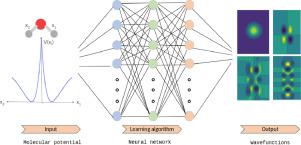Communications in Nonlinear Science and Numerical Simulation ( IF 3.9 ) Pub Date : 2021-08-31 , DOI: 10.1016/j.cnsns.2021.105989 L. Domingo 1, 2 , F. Borondo 1, 2

|
In this paper, we design and use two Deep Learning models to generate the ground and excited wavefunctions of different Hamiltonians suitable for the study of the vibrations of molecular systems. The generated neural networks are trained with Hamiltonians that have analytical solutions and ask the network to generalize these solutions to more complex Hamiltonian functions. Since the Hamiltonians solutions used to train the neural networks are computationally cheap, the training process is fast and efficient. This approach allows to reproduce the excited vibrational wavefunctions of different molecular potentials. All methodologies used here are data-driven, therefore they do not assume any information about the underlying physical model of the system. This makes this approach versatile and can be used in the study of multiple systems in quantum chemistry.
中文翻译:

用于计算振动波函数的深度学习方法
在本文中,我们设计并使用两个深度学习模型来生成适合于研究分子系统振动的不同哈密顿量的基波函数和激发波函数。生成的神经网络使用具有解析解的哈密顿量进行训练,并要求网络将这些解推广到更复杂的哈密顿函数。由于用于训练神经网络的哈密顿解在计算上成本低廉,因此训练过程快速高效。这种方法允许重现不同分子势的激发振动波函数。这里使用的所有方法都是数据驱动的,因此它们不假设有关系统底层物理模型的任何信息。



























 京公网安备 11010802027423号
京公网安备 11010802027423号